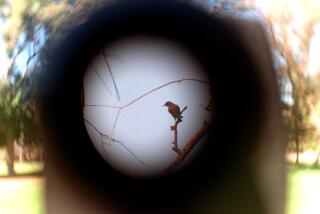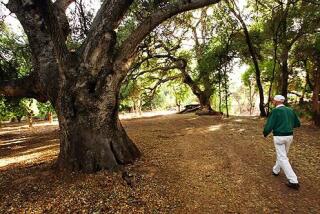Wild About Lichens
They are chartreuse and vivid orange, velvety black and speckled red. They are shaped like ruffles, flowers, golf tees, tiny volcanoes, and even letters. And most people never notice them. Those who do tend to get obsessed.
Lichens, considered by their fans to be “the essence of wildness,” thrive only in clean air and pristine environments. Far from cities, they color the wilderness, growing on rocks, trees and soil.
Most people, if they think about them at all, think lichens are a stain, or a texture or “simply a moss,” sniffed Irwin Brodo, a lichenologist at Ottawa’s Canadian Museum of Nature.
One sure way to aggravate a lichenologist is to call a lichen a plant. They are not plants. They are a strange and sometimes aggressive collaboration between a fungus, which cannot make its own food, and an alga or bacterium, which can. Biologists call the alga or bacterium portion of the combination a “photobiont,” meaning it uses energy from light to create food that it shares with the fungal portion of the lichen. The fungus, in turn, stores water and in other ways protects the photobiont from the often-harsh environments in which lichens exist.
If separated in a lab, the algae and cyanobacteria go back to their normal colonies; the fungi produce “a characterless heap,” said Brodo. But together, the components grow into complicated, sculptural structures.
They have many mysteries. For hundreds of years, botanists, stumped as to how lichens reproduce, called them “cryptogams,” meaning hidden sex. (Lichens put out packets with both algal and fungal cells to get new lichens started.) Chief among remaining mysteries, said Brodo, is why they are so little noticed.
“They have an undeserved reputation as being at the low end of the totem pole,” he said.
Lichen experts argue that paying more attention to lichens could pay off. Much of the Los Angeles Basin, for example, is now barren of lichens. This is because lichens, which take in water from the air instead of through roots, are highly sensitive to air pollution. In many places, Brodo said, lichens are used as air pollution monitors.
*
Lichens Secrete 600 Byproducts
Lichens are also chemical factories, secreting 600 byproducts. They have been used as dyes for Navajo blankets and, mixed with urine, dyes for the royal purple robes of England. They contain poisons and antibiotics. Lichens have been used in medicinal salves and teas around the world. Japanese scientists view them as potential cancer-fighting agents.
These chemicals are probably produced as a defense against predation. Lichens are extremely tasty to animals; they make up 90% of the winter diet of caribou and line the nests of flying squirrels. “Because the squirrels also eat these lichens, they can munch on their homes whenever they are hungry,” Brodo notes.
People don’t generally eat lichens because they are difficult to digest. But the Inuit do enjoy partially digested lichens taken from the rumen of recently killed caribou. Lichens known as “rock tripe” may have kept members of an ill-fated 1819 Arctic expedition alive. Some scholars believe “manna from heaven” was actually a kind of lichen that once drifted across Middle Eastern deserts and became wet and edible with the morning dew.
Lichens also play a crucial environmental role. They colonize bare rock and then secrete acids to eat at the rock, laying the groundwork for plants that will come later. They also increase the fertility of soil.
“They’re not just pretty faces,” said Brent Mishler, who heads the Jepson Herbarium at UC Berkeley.
Poets and writers who cherish quiet places, like Henry David Thoreau, have often waxed eloquently about the existence of lichens on trees and gravestones. But it is the beauty of lichens, particularly seen up close, that has inspired the latest homage to the tiny life forms. Brodo, along with nature photographers and self-taught Berkeley lichen experts Sylvia and Stephen Sharnoff, have distilled their admiration of the “lowly lichen” into an unlikely product: a lavish, richly illustrated coffee table book on the lichens of North America.
*
Possibly the Audubons to the Lichen Family
Reviewers say the book could do for lichens what John James Audubon did for birds and E.O. Wilson did for ants: make them visible to countless Americans.
“The minute people look at them under the magnifying glass, they are blown away,” Mishler said. “It’s like a little world.”
The book was the brainchild of the late Sylvia Sharnoff, the daughter of Victor Durant, a science photographer at UC Berkeley. Sharnoff continued her father’s legacy after his death, photographing lichens that would be at home in any Dr. Suess book as she backpacked through California.
Because lichens are so small and cameras must be placed so close for shots, many photographers had been unable to capture their color and detail. Sharnoff combated that by using an invention of her dad’s: a camera mounted with two braced flashes that poured light onto the lichens
Originally, Sylvia Sharnoff thought she might spend three weeks reading about lichens and put together a “modest book,” Stephen Sharnoff said. “She started because they were so interesting and strange to look at. It just grew.”
Stephen Sharnoff soon “got hooked” and gave up his construction job to help. The pair poured their savings into a small RV and crisscrossed the country, eventually photographing 1,300 species of lichens. They went to hot spots like the Channel Islands, where lichens thrive in fog, and Appalachia, aging mountains with lichens that grow nowhere else. They found a soul mate in Brodo--and were welcomed into the botanical fold.
“There is a long tradition of amateurs being accepted by PhDs in botany,” Stephen Sharnoff said.
They were not so welcomed, however, on publishers’ row.
“Publishers,” said Brodo, “thought we were obsessed by something esoteric that wasn’t very important.”
It was not an uncommon response. “If you just mention the word ‘lichens’ to people, they just shrug and get a vague, faraway look on their face,” Sharnoff said. “If you show them color pictures, though, they get interested.”
Editors at Yale University Press, however, loved the idea. They supported the project--all 795 thick, glossy pages of it. The gamble seems to be paying off. Released late last year, the $70 book has sold half of a 7,500-copy press run, Sharnoff said. For a time, he added, “Lichens of North America” was the 30th-most popular book sold by Amazon.com.
Sylvia Sharnoff didn’t live to see the finished project. She died of cancer in 1988.
“It means so much to me,” Stephen Sharnoff said, “that Sylvia’s vision of getting the world excited about lichens is actually coming true.”
*
On the Internet: www.lichen. com

